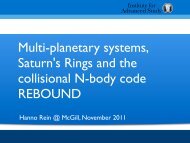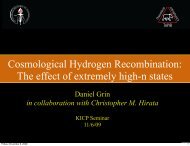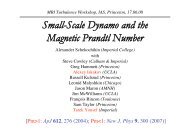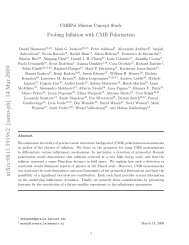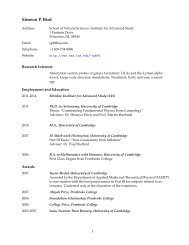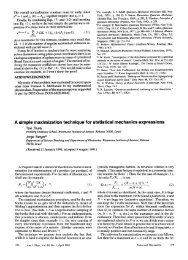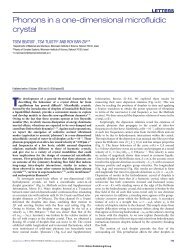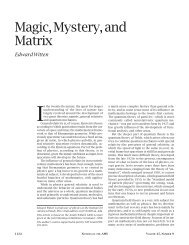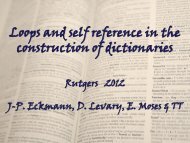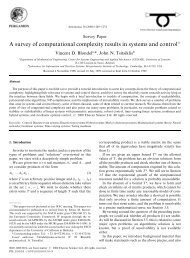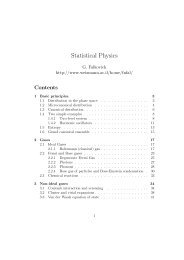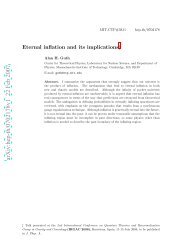Introduction to String Theory and D–Branes - School of Natural ...
Introduction to String Theory and D–Branes - School of Natural ...
Introduction to String Theory and D–Branes - School of Natural ...
You also want an ePaper? Increase the reach of your titles
YUMPU automatically turns print PDFs into web optimized ePapers that Google loves.
where we have used the commuta<strong>to</strong>r (58) for the oscilla<strong>to</strong>rs. From this we see that the time–like ζ’s will<br />
produce a state with negative norm. Such states cannot be made sense <strong>of</strong> in a unitary theory, <strong>and</strong> are <strong>of</strong>ten<br />
called 3 “ghosts”.<br />
Let us study the first constraint:<br />
The next constraint gives:<br />
(L0 − a)|ζ; k>= 0 ⇒ α ′ k 2 + 1 = a, M 2 =<br />
(L1)|ζ; k>=<br />
α ′<br />
1 − a<br />
α ′ . (66)<br />
2 k · α1ζ · α−1|0; k >= 0 ⇒, k · ζ = 0 . (67)<br />
Actually, at level 1, we can also make a special state <strong>of</strong> interest: |ψ >≡ L−1|0; k >. This state has the<br />
special property that it is orthogonal <strong>to</strong> any physical state, since < φ|ψ >=< ψ|φ > ∗ =< 0; k|L1|φ >= 0. It<br />
also has L1|ψ>= 2L0|0; k>= α ′ k 2 |0; k > . This state is called a “spurious” state. So we note that there are<br />
three interesting cases for the level 1 physical state we have been considering:<br />
1. a < 1 ⇒ M 2 > 0 :<br />
• momentum k is timelike.<br />
• We can choose a frame where it is (k, 0, 0, . . .)<br />
• Spurious state is not physical, since k 2 = 0.<br />
• k · ζ = 0 removes the timelike polarization. D − 1 states left<br />
2. a > 1 ⇒ M 2 < 0 :<br />
• momentum k is spacelike.<br />
• We can choose a frame where it is (0, k1, k2, . . .)<br />
• Spurious state is not physical, since k 2 = 0<br />
• k · ζ = 0 removes a spacelike polarisation. D − 1 tachyonic states left, one which is including<br />
ghosts.<br />
3. a = 1 ⇒ M 2 = 0 :<br />
• momentum k is null.<br />
• We can choose a frame where it is (k, k, 0, . . .)<br />
• Spurious state is physical <strong>and</strong> null, since k 2 = 0<br />
• k · ζ = 0 <strong>and</strong> k 2 = 0 remove two polarizations; D − 2 states left<br />
So if we choose case (3), we end up with the special situation that we have a massless vec<strong>to</strong>r in the<br />
D dimensional target spacetime. It even has an associated gauge invariance: since the spurious state is<br />
physical <strong>and</strong> null, <strong>and</strong> therefore we can add it <strong>to</strong> our physical state with no physical consequences, defining<br />
an equivalence relation:<br />
|φ >∼ |φ > +λ|ψ > ⇒ ζ µ ∼ ζ µ + λk µ . (68)<br />
Case (1), while interesting, corresponds <strong>to</strong> a massive vec<strong>to</strong>r, where the extra state plays the role <strong>of</strong> a<br />
longitudinal component. Case (2) seems bad. We shall choose case (3), where a = 1.<br />
It is interesting <strong>to</strong> proceed <strong>to</strong> level two <strong>to</strong> construct physical <strong>and</strong> spurious states, although we shall not<br />
do it here. The physical states are massive string states. If we insert our level one choice a = 1 <strong>and</strong> see what<br />
3 These are not <strong>to</strong> be confused with the ghosts <strong>of</strong> the friendly variety —Faddeev–Popov ghosts. These negative norm states<br />
are problematic <strong>and</strong> need <strong>to</strong> be removed.<br />
16



